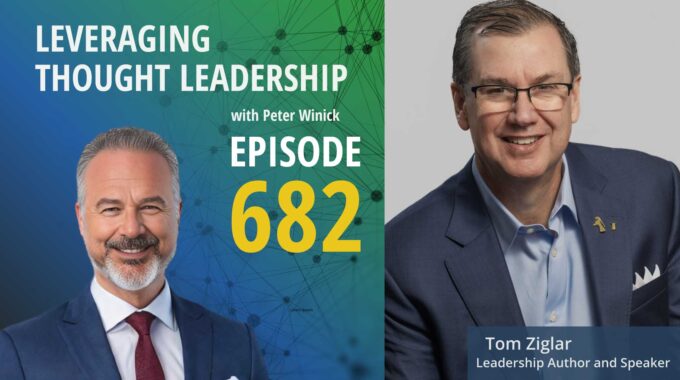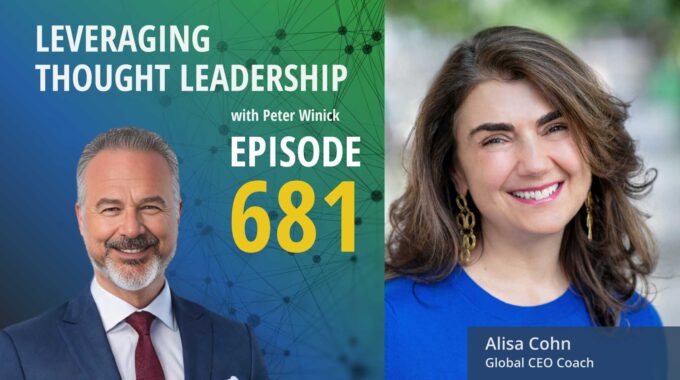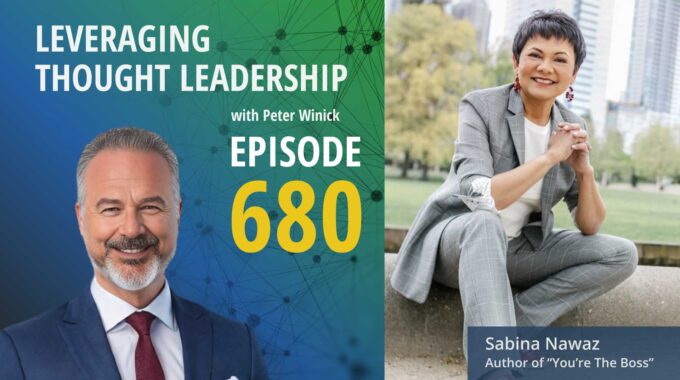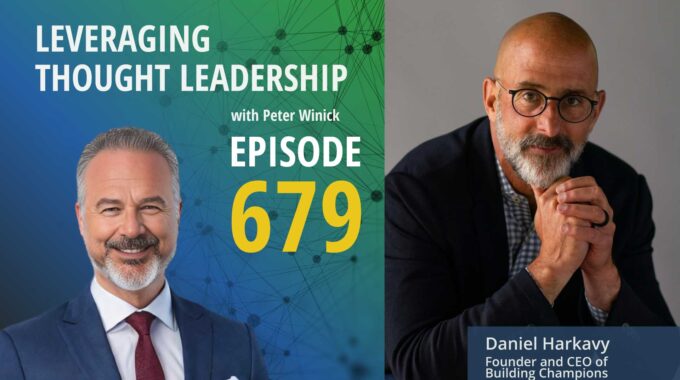How AI, Programs, and Trust Turn Ideas into a Life-Changing Business This episode explores how…
The Science of Leadership | Lindy Greer
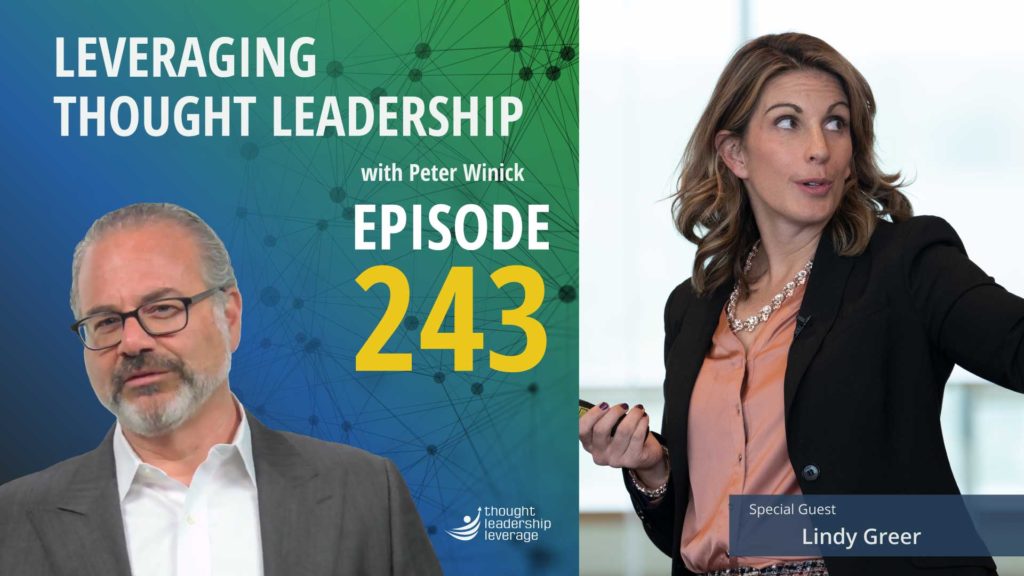
Getting Connected and Staying Connected in a Diverse Thought Leadership World.
An interview with Lindy Greer about the science of leadership, what organizations are looking for in leaders and the art of leading in our current physically distanced world.
We interviewed Lindy Greer, Associate Professor of Management & Organizations at Ross as well as the Faculty Director of the Sanger Leadership Center. Her research focuses on how to lead effective organizational teams, with specific interests in leadership skills in conflict management, diversity and inclusion, vision crafting, and the communication of emotions. Today, she talks to us about ways to build thought leadership, and why good teaching strategy counts. She focuses on how to design and lead effective organizational teams, with specific interests in intra-group hierarchy, conflict, diversity, leadership, and emotion.
Lindy introduces us to what is being taught to leaders and how science and data are playing a bigger role in the instruction than ever before. We explore what companies are looking for in leadership both from the perspective of older audiences and in the digital world. She spends some time sharing her experience publishing her content beyond the world of academia, how to gain credibility and tips for co-authoring! Then, we wrap the episode up discussing distance working and learning, as well as the best practices being used to create a more efficient and productive workforce for remote working.
Four Key Takeaways from the Interview:
- What traits thought leaders need to consider for good leadership.
- How thought leaders can gain credibility and get published in various mediums.
- What thought leaders can do to create a strong team working remotely.
- What does it mean to build transformative thought leadership?
The science and data behind your thought leadership is important. Research provides you with the foundation to support your innovation and can validate your content. Contact Thought Leadership Leverage for assistance.
Transcript
Peter Welcome, welcome, welcome. This is Peter Winick, I’m the founder and CEO of Thought Leadership Leverage. And you’re joining us on the podcast today, which is Leveraging Thought Leadership. Today, my guest is Lindy Greer. She’s an associate professor of management and organization at U-M University, Michigan. Stephen Ambrose, School of Business. She’s also the faculty director of the Center Leadership Center. Her research focuses on how to lead and lead effective organizational teams with specific interest in leadership skills, conflict management, diversity and inclusion, vision crafting and the communication of emotions. She’s been published in over 40 top publications or works, been cited over 500 times. She’s been in well-known media outlets like The New York Times, Forbes and. Goes on. She’s got her. What do we got here? Yes, from Warton PhD from University, Netherlands. So, we could spend a lot of time on your bio, which is typically the case here. But really getting to the good stuff are welcome. Are you today?
Lindy Greer Thank you. It’s good to be here.
Peter So couple a couple of thoughts I had get ready for today. One is one of the questions I’d like to ask is first. You know, sort of. How did you get here? Right. So, this isn’t a typical path for most folks. So, tell us about your journey a little bit.
Lindy Greer So I always wanted to go make the world a better place. I was convinced I wanted to do something like human rights law. Go save the world in that manner. And when I was an undergraduate, I was a work study student for a professor who did research on conflicts and teams at work. And I just fell in love with the power of this research to make the world a better place. I can remember my parents’ home from work complaining about fights with coworkers. And like the energy would come into our family and every family deals that and deals with the toxicity of the workplace the time. Sure, we could provide tools for everybody to understand how to navigate and people sort of work better. You know, that’s a service to everybody, you know, product. And that potential is a bit like human rights law. And so, I fell in love with and then going off to do my PhD. And being a professor in this area now, what will be 20 years next year?
Peter Wow. Very cool. Very cool. And you said an interesting place. Not only you, professor, and I thought leader in your own right, but at the – let me get the name right – at the Sanger Leadership Center. That’s really the executive center.
Lindy Greer Now, it’s a separate from its second partner with its second a lot. The center has oversight over how leadership is taught across the university and to some extent also engages with our partners next decade as long as marketing communication at the School of Thought Leadership.
Peter Got it. OK.
Lindy Greer Have an integrated platform of strategy over how do we talk about leadership at Roths within the school and outside of the school? How do we generate our own bold ideas and research that we then disseminate, you know, how to have coherency and how we teach it in the classroom. And how it is brought into our co-curricular.
Peter So let me ask you of the meta question then based on that and a couple others. Where if anywhere, just thought leadership fit into the current universe of leadership. Because I’m seeing and reading and absorbing different sort of perspectives on that.
Lindy Greer At least for me as a scientist. I mean, into this discussion for me, leadership, the struggle a lot with being data driven in terms of them out there, you know, and even within the academic world, leadership doesn’t have a good name for many years. The research wasn’t very rigorous.
Peter Right.
Lindy Greer And maybe five, five years ago, there was a big rejuvenation. There’s a key a seminal scientific article that came out that really challenged the way that we talked about leadership and science and opened up a new era of more quantitative behavior driven research and leadership, made a legitimate study with some business schools. Now, the last five or 10 years, you’ve seen a lot of business school professors emerged with ideas and data on leadership that I think have the potential to make it even a bigger impact instead of what some of what has been historically put out there. So, it’s a really exciting time, I think, to be at this intersection of sort of science and data and leadership.
Peter Because a lot of leadership, at least in the non academic, you know, sort of the business, pop culture, whatever. Some of it could be charisma. It could be storytelling. It could be. I mean, it’s a plethora of stuff. And there were no standards. Right. And, you know, I think we’ve seen the maturation of behavioral economics come up to a par where it’s a respected science. Now, I think we’re seeing that in many areas with leadership, they’re still sort of this like the cult of personality, of leadership. But I I look at the scientific gravitas, too.
Lindy Greer Yeah, it was interesting. Said the part of the committee of so many school business schools have a leadership center like what I direct at Ross. So there’s a consortium of faculty center directors who work together. And so we’re currently working with the AIDS CSB to look into accreditation for a leadership development. So can we have consensus within science? What are the key objectives we should be teaching on leadership? Apex leaders need to know and be able then to also standards for how do you educate that? How do you train that? You evaluate it to show how. What we’re doing within universities on leadership development is different than some of the ones down with the gurus or the hero stories of what you may not necessarily be wedded to science and data in the same way that university driven which educationists.
Peter I love that because you know, someone gets an MBA. The technical side, you can make a fair you know, you can make a good assumption that they know how to read a balance sheet. They know how to do cash flow statements. They know how to do some critical thinking, etc. But the whole leadership thing, you still roll your eyes and go, wow, you know, just because you have an MBA doesn’t necessarily.
Lindy Greer Yeah, exactly. And so hopefully better at that. So schools are pretty transformative added. Some aren’t like what is it that works? What is it that doesn’t? And because there’s been so much data growth in the science for the last few years, I think we’re getting much closer to consensus than we ever have been over what are the behaviors that we need to teach? And how do you do that? Which is the transition point for a field by which you have a strong enough paradigm, you could go for things like accreditation.
Peter Excellent. So where I was trying to go before I went to take a different angle on it. Now part of what you do is work on the executive bedside. And I’m always fascinated with executive MBA at Wharton, Harvard, Tuck, whatever. All the usual suspects is. That’s an interesting place where, you know, academe is meeting world class business. And what are you seeing? What are you seeing as sort of the trend? What are the companies looking for when they come to you? Just think of it as you’re the supplier and they’re the buyer. What are they looking for today? Looking for today? That’s different than maybe five years ago. Where did the what sort of cutting edge? Give us a sense of sort of state of the art.
Lindy Greer There are a few things that promise to do, that interest in about second and second audiences and the companies come into schools like Ross, Stanford, Harvard, for example, and what they want is leadership.
Peter OK, interesting.
Lindy Greer Historically, that continues to be. But if you go to, like, you know, younger generations that we educate, such as undergraduates or MBA students, they kind of want leadership. They’re not desperate for it. And the more senior the audience you get and corporations, the more they’re desperate for leadership training because they understand how hard it is. You know, if you look within a C-suite, most of your time is spent managing people. Sure. And when they’re 20 is just leadership. You know, they think that it’s important, but it’s not daily pain.
Peter And so the difference between the theoretical and the applied. Right. So if I’m a 24 year world MBA student, I might desire to learn leadership. But if I’m a thirty seven year old that’s been going around the block a few times, going for my executive MBA. Now I get the gap. I’ve had a good leader. I’ve had a badly I’ve been a decent leader. I’ve tried to be a better leader. So what are the capabilities in terms of sort of decomposing that into the capabilities that allow someone to develop so that they can be a better leader?
Lindy Greer Yeah, well, that’s the thing. That is like what these executives are hungry for the theory of the theory and a way in which you can apply a framework so you can immediately take back to your meeting and say, OK, this is situational one, I need to do this. And so I had in Playbook for how to lead on four undergraduate second select theory are strapped just because you haven’t lived it. Whereas that very same framework given to a CEO like, oh my gosh, like this is going to save my day. I know how to work with that. I know how to apply it.
Peter Um-hmm.
Lindy Greer To answer your questions, too, about what they’re looking for now, specifically, a lot of the CEOs in terms of what types of leadership skills and frameworks they are looking for. You know, how do I not manage in this digital world? On the whole of Google, everything’s uncertain and complex and crisis driven, especially right now. There’s a lot of hunger for that. And so this intersection of leadership with digitalization leadership with the global economy and leadership, what’s rapidly changing and uncertain world, what does that mean?
Peter And so let’s break those down. You said you said digital global economy. What was the last one?
Lindy Greer Uncertainty. Complexity, data.
Peter Right. So we can check all those three boxes today time, multiple times. So those are really sort of the presenting symptoms. I want to I want to lead in the digital world. We live in a global world. I want to lead a complex world. Right. Interesting. So how do you approach those problems differently? Or is it that effective leadership actually solves all three? From an education point.
Lindy Greer To do argue the effective leadership is effective leadership in certain key behaviors like the ability to align a team around a meaningful vision or communicate that vision on a daily basis in a way that speaks to hearts and minds. Those are core leadership skills that can transcend digitalisation, can transcend a diverse little team, and also can preserve alignment in the face of uncertainty. What are the examples? There might be a little bit of difference. I think many of the key frameworks that we have six everything even to speak right now in transition to remote work from face to face work. Remote work is indifferent. It just requires you to be even better at the people side of work. But it’s the exact same skills. You just have to do it even better.
Peter Right. Right, right. I mean, different tools, but you’ve got to get to the same place.
Lindy Greer And it’s critical that, you know, of coordinating apps and resolving conflict. Aligning vision is very important.
Peter I want to touch for a moment, given that you’ve been your works been cited five, 5000 times. Wow. OK, I missed is there and 40 publications. So, what would you recommend to someone, whether they’re an academic or not? You clearly are in terms of publications. So, academics was a little bit different twist, but framed it maybe in the sense of sort of crossover publication, not necessarily academic journals, because that’s a whole different universe. But when you’re getting published or desired to get published in more nonacademic journals, what are the things that go into your mind about how to do that effectively?
Lindy Greer Be more timely in terms of what’s in the news and what’s in the media right now. Speaking of things that people have a hunger for. I mean, braless stated, whenever you’re teaching my mind, you need just one emotion in the classroom standard second session. I will do I create experiences that are painful. Playing a card game where the rules are different. And, you know, you judge someone based on your rules rather than giving them the chance. And then I like diversity and bias in leadership. However, if you don’t have a chance to engage people face to face, how do you create that emotion? Then I think tapping into society’s emotions like whatever is OK right now is another way that you sort of engage that emotion whenever you think about any of this. You’re transitioning into the practitioner publications for me, to stick to emotion. You know, if you’re in the classroom environment, you can create emotion in the classroom that makes learning memorable. And if it’s just a written piece that I was reading on the fly, how do you tap into an emotion that they’re going to remember and understand why that framework we’re talking about is important? As of right now, everybody is feeling emotions around remote work. Sure. That is something that I talk in a lot more on about in the media right now than I normally do it just because I know it’s a…But if I go, don’t talk about some my usual soapboxes on diversity or vision.
Peter So could you, could you split that then between the tone of an article which you’re looking for, an emotional response from the reader or emotional connection or resonance or whatever. And the process of pitching the article talkers was a little bit because, you know, I unfortunately see so many folks writing so many things that never see the light of day because they don’t really understand how to articulate the value that they’re bringing to the person they need to pitch to you. Could you give maybe an example or two of how you pitched in, how it works?
Lindy Greer Yeah. I mean, so with pitching having credibility helps. Like when I was younger coauthoring with professors that were very famous in the field. You go to H-B are just like having that credibility helps. And certainly, if you’re at one of those transitional publications like an HP are able to access to the data, you know that your solution is actually data driven. And that could be coming from practice. You to sell the value of the data and then that the problem you’re solving matters. And that would be the timely piece. It’s also being able to sure say why that solution is needed in the world, especially right now, and why you’re the person to write that solution.
Peter So let me push one further on that. So, I love the idea of coauthoring, someone that has more credibility or has been around the block a little bit longer. More publishing than you’ve been up to now. There’s a double pitch. How do you how do you identify and pitch to that partner then academic, whoever they may be like? Hey, listen, I’d like to coauthor this with you. What does that look like?
Lindy Greer Subpopulation, especially for people. They’re super famous or super busy. And so how do you make it in their interests? So how do you make it easy to know if I can write the whole thing? You know, like here’s an example of work I’ve done. Show my own confidence that it’s worthwhile to work with me. I’ve read your profile. I think it would be good for your brand or whatever to have this face out there, too. So how do you make it a win and make it as easy for them to say yes as possible? You also have a foot in the door of having a personal connection like any type of thing in life. I’ve almost never had a cold introduction pan out. Sure, someone who knows the person you want to coauthor with and get the foot in the door that way. That helps.
Peter Fantastic. And also putting it out there like, hey, this is something I’m interested in. All right, cool. So lastly, I want to spend a moment or two, if we could because it’s accelerating so quickly now. You know, we’ve been talking about distance learning and e-learning and digital learning for 20 years. And a lot of that has been a theoretical conversation backed up by technology that’s been subpar. The technology’s finally there. And given what we’ve all been living through, the need and the demand is there, what are your thoughts in terms of maybe some dos and don’ts? And, you know, there’s always been the debate over, you know, what do you need that face time for how to use that effectively, how to use the tools. And I think a lot of people have struggled and we’ve defaulted to this old school model that has now been shattered, you know, unexpectedly quickly.
Lindy Greer Yes, if you look into the companies that do remote work well, as well as a lot of resources than there are in the last 20, 30 years on the differences between virtual or remote communication versus face to face. Any context for people? And so, the companies that do a remote well typically will do onboarding face to face and work together every six months to make sure everybody is able to actually understand personality, understand nuance, understand challenges. And then when they’re not face to face, then they scaffold in the people side of work and a much more intentional way than we do face to face. Companies that are full or remote are going to argue strongly that they’re better at work, broadly stated and being more efficient, more productive, more successful than face to face teams because they can’t be sloppy and they’ve had a gold and the infrastructure around people to be really good at the people stuff. You know, the role structures are much more clear. Their end of year processes are much more intentionally designed. They’re much more intentional about what the culture is and how to bring that into their environments in terms of like building in your virtual coffee cooler, whereas a Face-To-Face organization if you have a coffee cooler. But did you potentially think about how it would be used as a cultural tool or not? Whereas for a remote organization building a coffee cooler online part, a level of intentionality that Face-To-Face do so again is good teams that are remote, you know, golden moments, a face to face to face. You need that absent. Those moments have built in really intentional cultures from people side of work that allow them a face to face.
Peter Sounds like not leaving anything digitally. You have to really be deliberate, bit deliberate about the things that have been serendipitous. Hey, if you’re in the office and I’m in the office, I can say let’s go grab a cup of coffee. You’re read random bumpkins and all that and you don’t have that. And it just seems limited environment to create it. That’s interesting because I can tell you more experience when we lit up slack. I think about a year ago I was a little reluctant with another tool and were already on Dropbox, 72 other tools. My entire theme is that there is a lot of, you know, they created a chat room that was mostly silliness. At first, I was like, great, now we’ve got another tool to share, you know, cat videos. It was like it was actually really important. You know, the Monday morning. How was your weekend? Oh, we went to dinner and, you know, saw this movie. And I’m like so I just sort of stood back and watched. But I think I feel validated now that I didn’t say that silly stop something that there is a there’s a human need for that sort of stuff.
Lindy Greer You need to have a need for context like that and building the killer. But then the more that you are intentional about how it speaks to culture and mission, the better.
Peter Yeah.
Lindy Greer Shop to shop. But you know, if you’re a company that a certain manufacturer and you have a builder’s hour. Yeah. Over the weekend or the project, they’re building for the team that week.
Peter So put themes that are related as opposed to just going in there. And as we start to wrap any final thoughts on best practices, because I think a lot of people now are going to quickly take. You know, classroom based, workshop based, in-person based stuff that they know has worked well for a number of years and rush through the process to, quote, digitize, and we’re gonna see all sorts of things that are, let’s just say, have less than the desired outcome because of that. What are the things they should do?
Lindy Greer Nothing short with the material but things to keep in mind when you’re going through that instructional design and translation process to realize that going online requires more intentionality about how you communicate and how you educate and then face to face. I taught in the online MBA program for Ross this year. One of the first top ten MBA programs to launch an online MBA such at me about half a year to prepare my class. And I learned a lot in terms of how do you set lesson goals for every specific lecture? Seven minutes of your lecture. What is the point you’re trying to get across? Because in an online environment, you can’t pay attention to a 90-minute video of someone speaking or even a synchronous 90-minute live lecture, someone sitting right like in person. You can kind of like draw on participation. Off you can be sloppy, just like what was mentioned about remote teams earlier. It’s the same with a. You can’t be sloppy online. It just doesn’t work. And so I think best practices are realized. And it’s not just going to be in a video camera on for what you did, Face-To-Face. This is like rethinking how you change. And I think some of the best learning that I got from this is thinking in terms of attention spans like seven minutes. Right. I’m breaking up your time with the students in a much more structured way rather than say, OK, we’re going to do a 90-minute live lecture where I’m just talking.
Peter Right.
Lindy Greer OK. Like, what are the different points within that lecture? How do I break them up into discrete learning moments? So maybe that’s crazy.
Peter It’s almost like Lego pieces. So instead of the 90-minute lecture on X that most academic professors get up and do 90 minutes, it’s like, wait, I don’t know why lego that out in seven-minute chunks or something.
Lindy Greer Yeah. And then actually taking advantage of the online environment that you could actually have more opportunities for asynchronous learning, more flexibility to where maybe one lecture doesn’t even need to be synchronous. And instead you have like a ten-minute video, a ten minute exercise online, maybe 20 minutes, a try to discussion assistance we do with our own time that we have a lot more bite sized chunks. And it’s honestly for me, I thought of the online MBA program I did a lot this past winter. The students learn more this way than they did face to face because you’re keeping it by size. They do it when they want. They do, you know, 10 minutes of it. And then they go back to that meeting and they can immediately apply it versus a 90-minute lecture where you’re not trickling it in through the day for them to use as they go.
Peter So it’s almost a little bit more pull than push too.
Lindy Greer Right, absolutely.
Peter And I think the reality is people’s attention spans were probably always pretty short. And then, you know, given everything. Beeping in emails and all the other stuff we deal with, these should certainly haven’t gotten longer. And if we can accommodate that a little bit instead of fight it. So, this has been fantastic. I appreciate all your all your shared and your journey and your insights has been great.
Lindy Greer Thank you so much for having me. Today was fun.
Peter My pleasure.
[/vc_column_text][/vc_column][/vc_row]

